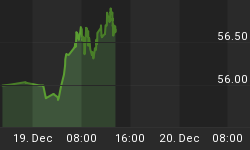The stock market continues to make new highs, yet none of the signs which accompany a market bubble are evident. Investors are asking, "When will the Dow finally correct?" By "correct" they mean "decline." However, a market correction doesn't always entail a decline for the major averages and can sometimes take the form of a lateral consolidation or trading range. That appears to be the case for the 2-month period from December through early February when the Dow and S&P made little headway.
In fact, in January the Dow Jones Industrial Average (DJI) recorded its tightest trading range of only 1.1% in over 100 years. This continues a prolonged sideways pattern in the Dow and other averages since mid-December when the post-election rally reached a plateau. The question everyone was asking was whether this plateau was merely a temporary "pause that refreshes" in an ongoing rally or the end of the rally and the prelude to another market setback. The Dow provided the answer to that with the last week's breakout above the top of the trading range ceiling. It has rallied each day since, putatively on the hopes generated by President Trump's forthcoming tax-related announcement.

While the bull market in equities continues, a surprising number of investors are either mistrustful of the rally or outright bearish. According to a recent article in BBC News, there are a growing number of wealthy and politically liberal U.S. citizens who are doing things in the wake of Donald Trump's election that were commonly seen by politically conservative citizens during the Obama years. That is, they are buying guns, becoming survivalists, and preparing for an impending catastrophe related to the Trump presidency, the article reported.
It was also reported that a number of wealthy Americans are preparing for what they believe is the apocalypse. According to Business Insider, some have purchased underground bunkers while other wealthy individuals are planning to emigrate to New Zealand. "Saying you're ‘buying a house in New Zealand' is kind of a wink, wink, say no more," said Steve Huffman, CEO of the Reddit web site. "Once you've done the Masonic handshake, they'll be, like, ‘Oh, you know, I have a broker who sells old ICBM silos, and they're nuclear hardened, and they kind of look like they would be interesting to live in."
The common denominator in these accounts is fear among the upper class. The dread of an uncertain future which was pervasive among America's middle class for much of the last eight years has now been transferred to the upper class. While it might be premature to ascribe this to the recent rush back into gold, bond funds and other safe-haven investments, it would seem that there is just enough uncertainty among the upper crust to account for the lack of movement in the major stock market indices since December.
Tight, narrow trading ranges in the major indices are launching pads for major moves in either direction. In the context of a bull market, they typically represent rest and consolidation before the next move higher. The odds technically favored this outcome, yet a substantial number of investors still don't believe in the strength of the bull market. This is reflected in the manifestations of fear among the upper class mentioned above, as well as in the path the market rally is taking.
There is talk among some observers that the market is undergoing a "melt-up". This is an erroneous application of that term. A classic melt-up is characterized by a runaway, almost straight-up and sustained market rally on high volume with widespread participation. The trajectory of the major indices since November can hardly be described as "melting up." Rather, the market's path has been measured and well-ordered, as the daily chart of the NYSE Composite Index (NYA) attests.

The real melt-up phase of this bull market hasn't even started yet. We'll know it has arrived when we see runaway stock prices coupled with increased participation among the legion of retail investors still on the sidelines. Even institutional investors are surprisingly tempered in their usual optimism, as expressed in their collective 2017 forecasts. Melt-ups have a way of surprisingly even the bulls in how high they carry the market averages before peaking. For now, though, a combination of fear and cautious optimism holds sway among investors and this alone is enough to argue that the bull market still has legs.
Mastering Moving Averages
The moving average is one of the most versatile of all trading tools and should be a part of every investor's arsenal. Far more than a simple trend line, it's a dynamic momentum indicator as well as a means of identifying support and resistance across variable time frames. It can also be used in place of an overbought/oversold oscillator when used in relationship to the price of the stock or ETF you're trading in.
In my latest book, Mastering Moving Averages, I remove the mystique behind stock and ETF trading and reveal a completely simple and reliable system that allows retail traders to profit from both up and down moves in the market. The trading techniques discussed in the book have been carefully calibrated to match today's fast-moving and sometimes volatile market environment. If you're interested in moving average trading techniques, you'll want to read this book.
Order today and receive an autographed copy along with a copy of the book, The Best Strategies For Momentum Traders. Your order also includes a FREE 1-month trial subscription to the Momentum Strategies Report newsletter: http://www.clifdroke.com/books/masteringma.html















